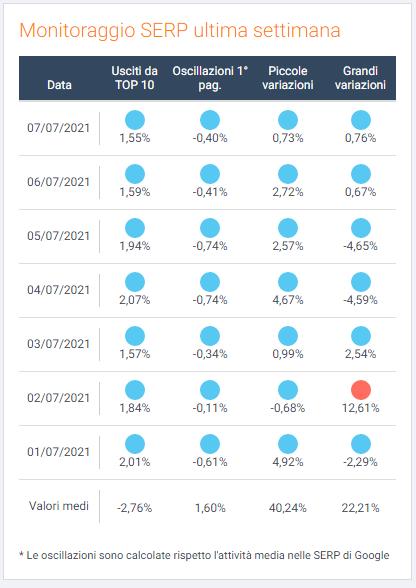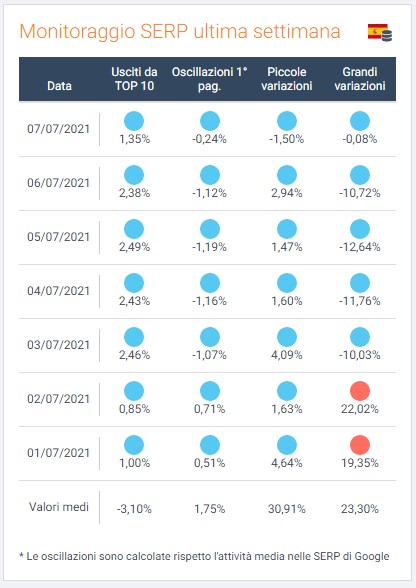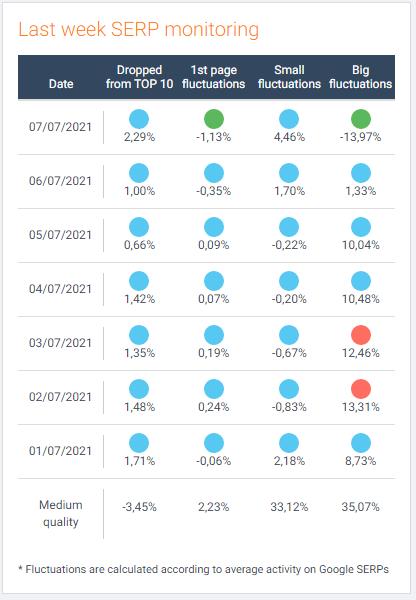Few shocks for SERPs from Google’s July 2021 Core Update
Dead calm or so in the Italian and Spanish SERPs, some more movement for those located in the UK and the United States: this is the extreme synthesis of the effects of the Google July 2021 Core Update, launched on July 1 and officially concluded after 12 days, as announced by the company account. Here is a quick analysis on the impact of this (umpteenth) update, which is added to the other algorithmic interventions started in recent weeks.
Info about the Google July 2021 Core Update
Before we dive into data and numbers, it’s good to do a little recap on this algorithmic update, which was quite abnormal compared to the others for a number of reasons.
It was, in fact, the tail of the previous June 2021 Core Update, which followed at a distance of not a month – while, instead, usually, such major Google updates fall on a quarterly basis or beyond, so much so that you have to go up to the December 2020 Core Update to find the last one before this pair.
As already mentioned, Google began implementing the main update of July 2021 around noon (US) on July 1, 2021, and announced that the rollout ended on July 12 at around 13:00 ET (19 pm Italian): so it lasted 12 whole days, two more than the June 2021 Core Update, which instead ended its application in just 10 days.
Anyway, it was a classic “core update”, which had effects on a global scale and not specific to a particular region, language or category of websites; the rollout conclusion means that the new search index has now been fully implemented in all data centers and that the search results should remain relatively stable.
So, from now on, any fluctuations we will see in the ranking will probably be due to the normal shift in search results – or to the effects of other Google interventions still ongoing.
Lots of ongoing Google updates
We must not forget that in the last month the search engine has been affected by a great deal of development and correction of some aspects of the criteria for evaluating the results.
Just to limit ourselves to the official and confirmed updates, we had the June 2021 core update, but also the spam update (an algorithmic intervention to penalize in Search sites that exploit situations of harassment and defamation to blackmail victims) and the Page Experience update (which will go on at least until August), without neglecting the potential effects of the implementation of Google MUM, which begins to be used to improve searches, as in the case of vaccines.
In short, the fluctuations of ranking in these weeks can depend on many variables (and this complicates in part the analysis), but it is still important to be able to identify the reason why you lose positions: as always, if this happens during a major update there is not much to do, except try to improve the overall quality of the site and content, in accordance with the historic 23 questions on page quality and Google’s advice to recover from a slump after an update.
Analisys of the July 2021 Core Update with SEOZoom
To verify the effects on the pages of the research results of this latest update we used the usual tools of the SEOZoom SERP Observatory: compared to usual, the movements were much lower or even apparently absent, almost completely atypical.
On the other hand, however, Google had anticipated that most sites would not notice these updates, and so this promise seems to have been kept.
What happened on Google Italy
The activity of changes and movements in the Italian SERPs monitored by SEOZoom in the period of release of the update was more than ever “in the norm”, an event that rarely occurs on the occasion of such updates.
The only area in which we found something different is that of the “Big fluctuations“, or the pages that have lost or conquered many positions in SERP: just on July 2, the first Italian day in which the update started, there has been a high peak in this Google’s testing activity (which is a sort of continuous quality test on the performance of web pages by the algorithm), which then fell back on more regular levels at least until July 14 (by now the rollout was already completed).
According to this monitoring, therefore, the effects of the July 2021 Core Update were not so much the first page of the results (where the variations were minimal or even absent), but rather the secondary pages, where many sites have suddenly conquered or lost previous placements, with notable jumps.
What happened on Google ES
It was practically calm even on the Spanish Google, which experienced a situation very similar to that monitored in Italy, with the highest peaks located in the area of “Great variations”, especially in days 2, 8 and 14 July (almost as in Italy); in addition, in Spain we also note the poisonous tail of the update, which just in the final days of its rollout – 10 and 11 July – has caused a bit of jolts between the “Small variations in SERP“.
Anyway, even the pages of the Spanish results do not seem to have been completely distorted by the July 2021 Core Update, or at least not in the Top10.
What happened on Google UK
A little more lively is the situation on the British Google, where the charts report more usual activity and fluctuations for the update period.
As in previous cases, however, there are virtually no reports of results coming out of the Top10 (or, at least, there are no deviations from the average activity recorded), while something changes in the other three categories analyzed.
In particular, on July 8 there was a slight peak in the fluctuations of the results within the first page (ie, changes of position between pages already classified in top10 on Google UK)while a little more consistent are the movements found for small and large variations in SERP. For example, in its final three days of rollout the update caused “small variations”, while the big ones were felt especially on July 2, 3 and 8.
Impact of the July 2021 Core Update on foreign SERPs
Even foreign analysts have dedicated space to study the impact of this update, using different data providers: Basically, it always emerges the feeling that the July update was even smaller and less impactful than the already bland June 2021 Core Update.
According to Barry Schwartz, there were 3 times when the update was perceived more – July 2, 9 and 12 – and even monitoring with different analysis tools confirmed this trend.
In particular, one notable feature was the relative brevity of the intense fluctuations of ranking, which did not extend for longer periods as was the case on other occasions; In addition, there was virtually contemporaneity between the Google ad and the first impact on the rankings.
In addition, the average intensity of the changes in SERP was lower than in June, and only 10% of the sites affected by the latest update experienced a reversal situation, or the case where a domain that recorded significant ranking losses in June achieved significant increases in July, or vice versa.
According to other data providers, many list and reference sites have been affected: for example, among the types of domains affected there are entertainment sites that include lyrics and information about songs and some travel sites.
Gianluca Fiorelli’s considerations on the update
Gianluca Fiorelli chose Twitter for a broad consideration of the impact of both Google’s Core Summer Updates, writing a series of tweets in which he analyzes some common background elements.
According to the SEO expert, now Google tends to be more accurate in classifying a site for its core business keywords, and eventually can devalue it for those only tangentially related, even if that site positioned itself very well with such keywords.
This combination can lead to a situation where the site also loses a large percentage of organic traffic, but its CTR is also increasing: a bearable effect, if the CRO of the site is well developed, while it can cause problems to those who are basing their business strategy on leads and a small conversion rate on a huge number of visits.
In this sense, says Fiorelli, “Google is forcing you to 100% rethink your SEO strategy“, and this is evident in any site that has based its strategy in creating a gigantic amount of content, such as all those news sites that have created “sections” of trivial news, the purpose of which is to get a click on affiliate links, or even those sites that have bet too much on their blogs to earn traffic, inflating them with content they probably shouldn’t have published.
Ultimately, there are six best practices that we can follow to avoid finding ourselves in critical situations:
- Rethink our strategy.
- Create content that truly affects entities directly related to our business.
- Diversify the type of format/content we create and publish.
- Set up a smart link building strategy, so to increase brand authority for its main entities.
- Diversify the marketing mix, using the web areas to increase trust, but mostly using social media and email marketing for this purpose.
- Do not beat yourself down if traffic falls, but engage in investigating the causes and act accordingly to improve the site.
Sites and categories impacted by the July update
An in-depth analysis also comes from Roger Montti, who brings together a series of observations by various authors for his analysis.
An interesting element that comes out of his article is the possibility that Google has reduced domain crowding, that is the crowding of SERPs by a single domain that is positioned repeatedly in search results. Before the July update, sites with multiple national top level domains (CCTLD) such as .uk, .tv, .ca domains tended to dominate Google search results for certain queries, but it seems they have now lost visibility (specifically, Pinterest ccTLDs).
Another notation concerns the increase of the People Also Ask (PAA) panel, the query refinement function designed to bring users to the answers they want to see.
Less positive one last notation, relative to the increase of low quality results in SERP in positions of good (or excellent) visibility.
Although Google is actively trying not to show such results, questionable quality pages continue to appear on the search engine: for example, there have appeared spam pages generated by the scraping of featured Google snippets ranked even first, thus surpassing the legitimate sites from which they scraped the content. To give the boost to these domains appear to be backlinks from high quality and seemingly clean sites (which, that is, do not seem to openly sell links).
Analyze drops to understand the reasons behind them
Montii also focuses on some useful points to clarify SEO side, because only by fully understanding what has changed and why the update has negatively affected the site in terms of positioning you can implement a relaunch strategy.
Many times algorithmic updates change the way Google understands the meaning of queries and/or Web pages (such as BERT), writes the author; this may involve moving up several sites, that better conform to the new understanding algorithms have of what a user is looking for when making a particular search query (what we simply call search intent).
So, some sites might lose positions not because they did something wrong, but because the algorithm’s judgment on what is relevant has changed.
In other cases, Google may introduce query refinement features such as People Also Ask, which can visually bring down a web page in position two to virtual position 5, pushed down by the box’s expansion.
This feature may also mean that another site, which appears among the questions, can gain more traffic because it is more topically relevant to the user who makes a particular query, gaining traffic from a query for which traditionally it was not awarded.
The site that fell below the PAA did nothing wrong and neither did the site that ranks in position 1, which in theory “could lose traffic to one of the sites in the refinement function of the PAA query”.
Again, Google may also introduce more rich results FAQs that may also affect the site’s visibility in search results (positively and negatively).
Therefore, there are many external factors to a website that can negatively affect the rankings, especially following a core update: if our site has suffered a negative change in search performance, then, it is good practice to first look outside of our pages to try to figure out what might have changed, and only then return to the site and see if you need to acquire information or take action to correct something.










